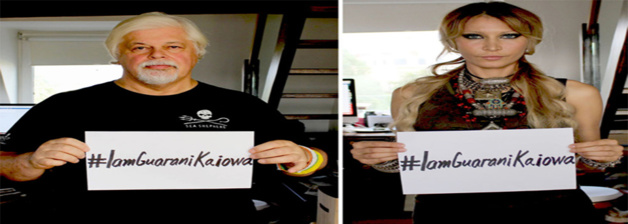
Screenshot of YouTube www.youtube.com/watch?v=ll8V59Adwas
Many associations have been defending the indigenous people’s cause for a long time. Today, the hard task is for the cause to find media coverage as newspapers reach a larger number of people and are thus able to sensitize a large portion of the population. When she came to Paris, Valdelice Veron managed to attract the interest of many editors. In addition to the media coverage, social media and celebrities also play an important role.
The role of associations
In Brasil, various associations defend the Guarani-Kaiowás. The International Committee of Solidarity with the Guaranis-Kaiowás tries to trigger a reaction of the population by publishing a large number of articles translated in various languages. The association Catarse launched a crowdfunding website in order to finance a documentary about the Guarani’s living conditions. Catarse believes that surveillance cameras should be installed in the indigenous camps in order for the recordings to serve as proofs in case of aggressions.

Outside of Brasil, associations like Planète Amazone share information about the cause. Gert-Peter Bruch explains: “We make them come to Europe in order for them to to reveal their problem […] which in turn creates pressure ”.
A weak media coverage, yet a process in progress
“200 ‘journalists’ were contacted for Guarani-Kaiowá’s press meeting. One registered”. A week after the arrival of Valdelice Veron in Paris, Planète Amazone complained about such a weak coverage on its Facebook account. In the end, about fifteen journalists attended the meeting. The organizers’ expectations were much higher. Nonetheless they rejoiced as they managed to appear on Le Monde, France Inter and even TF1. An AFP dispatch was also broadcast. Gert-Peter Bruch observed: “It moved a bit. Very timidly […]. The presence of Valdelice Veron in the Summit of Conscience on the Climate was highly covered by the media. Everybody who took part in the Summit were very moved by her speech ”.
However, the head of Planète Amazone remains puzzled. And with good reason, much of the media chose to ignore the topic. He blames, entre alia, Libération, The Figaro, France 2 and La Croix. We tried to contact these four editors to ask them about their silence on the topic, but no answer has been received to this day.
An encouraging start of the sensitization campaign
Facing difficulties to get the interest of the editors, Planète Amazone chose to use another support: social media. A week after Valdelice Veron came to Paris, an awareness campaign aiming at netizens was launched. The concept: take a picture of yourself with a sheet of paper or a screen where the inscription « #IamGuaraniKaiowá» can be read, then share it on the social media. The pictures were gathered by the association with the goal of being transmitted to the Brazilian government.

Many famous people, such as Pierce Brosnan, Paul Watson or even Pierre Richard played the game which considerably increased the reach of the message. The amount of pictures received by the association is constantly growing. They celebrate the fact that they now struggle to handle all the pictures.
The campaign “I am a Guarani Kaiowá” is promising, however it has not yet payed off. Indeed, the issue is still not part of debates. To have a real impact, the campaign has to reach the political sphere, in order to lead to concrete solutions.
The message of Valdelice Veron is crystal clear: “Mobilize! […] Write to your Judicial Courts! ”. She often recalls that if we do not react rapidly, soon enough, the Guarani Kaiowás will only exist on pictures.






























